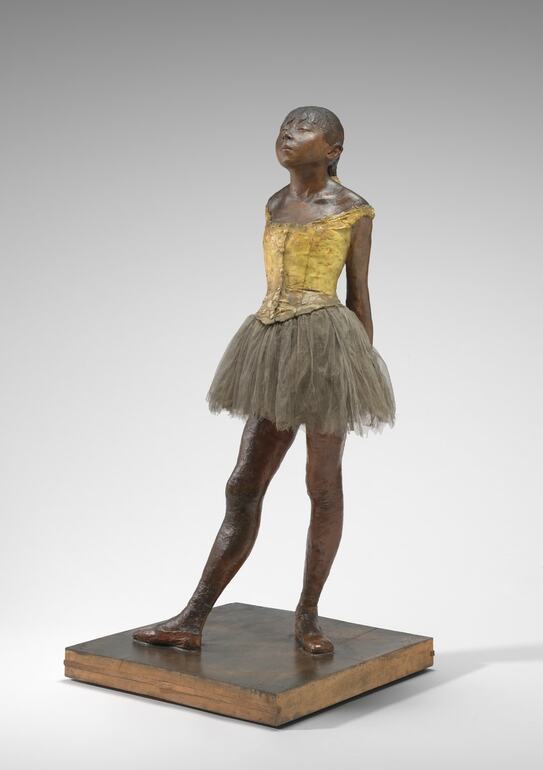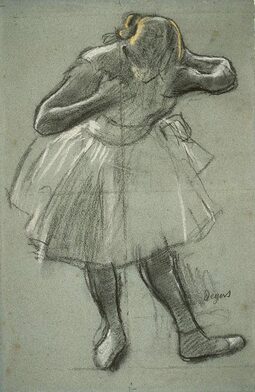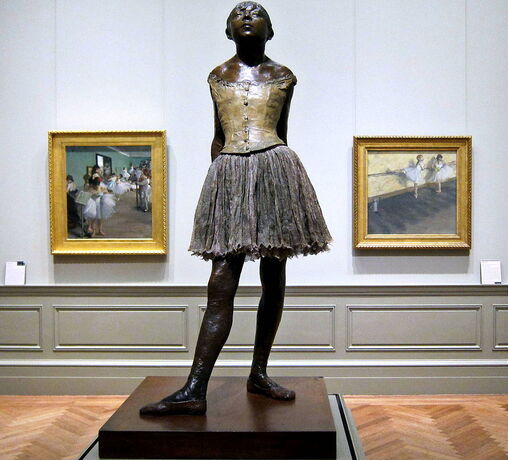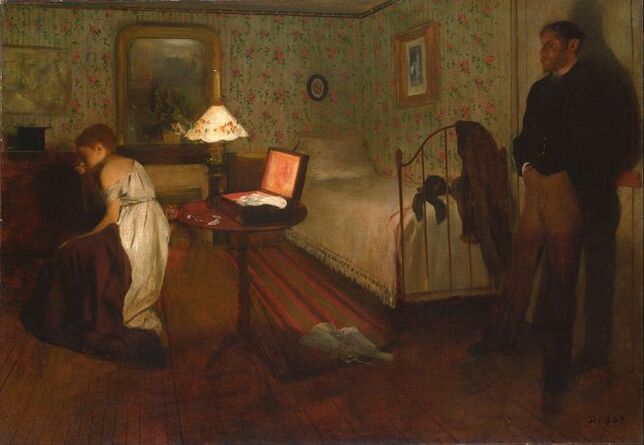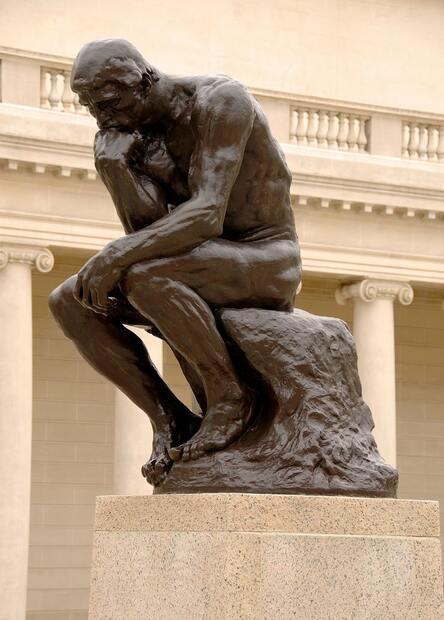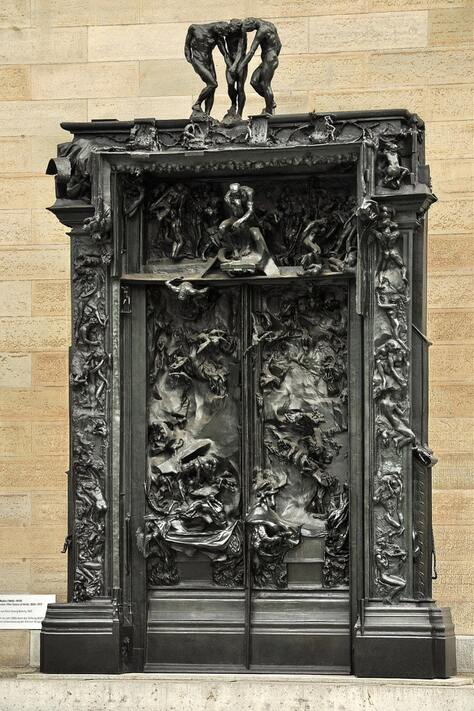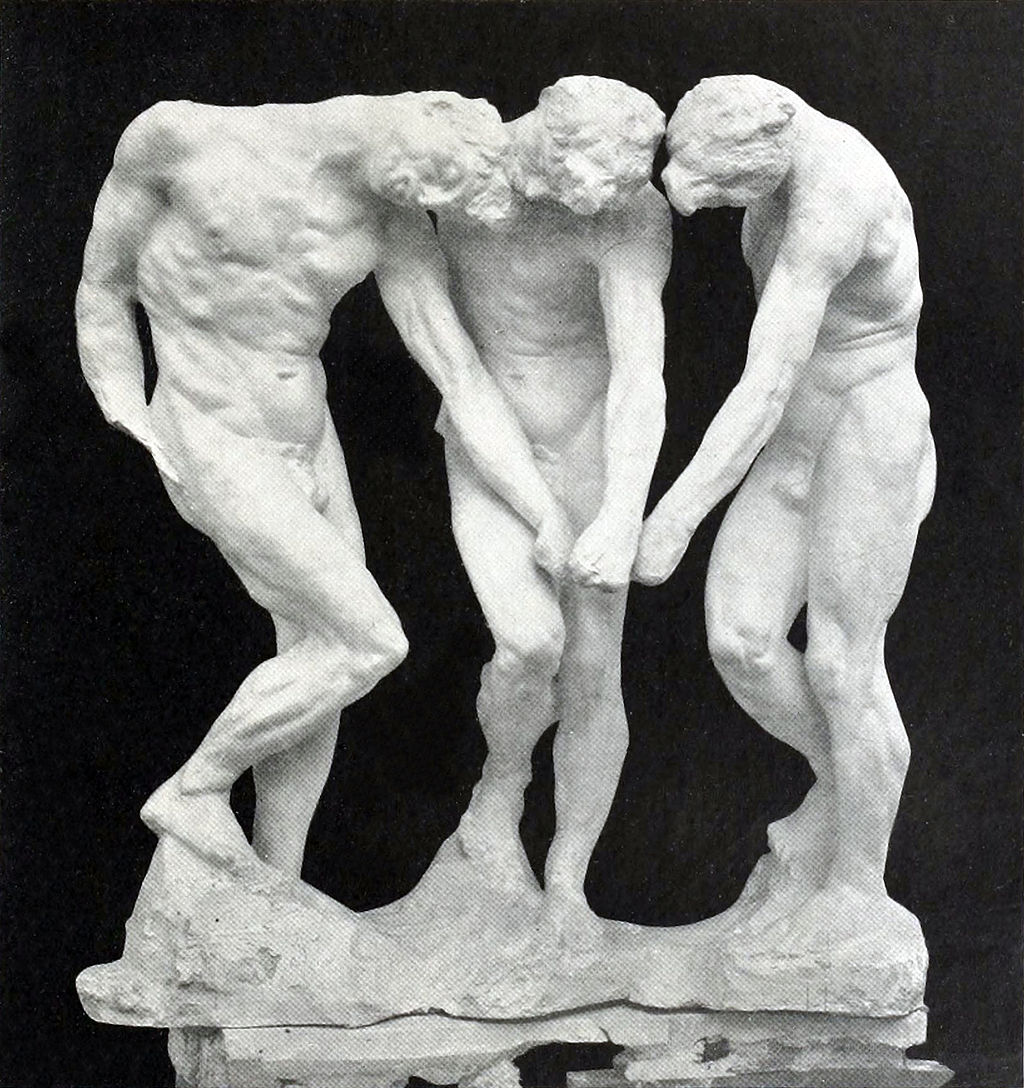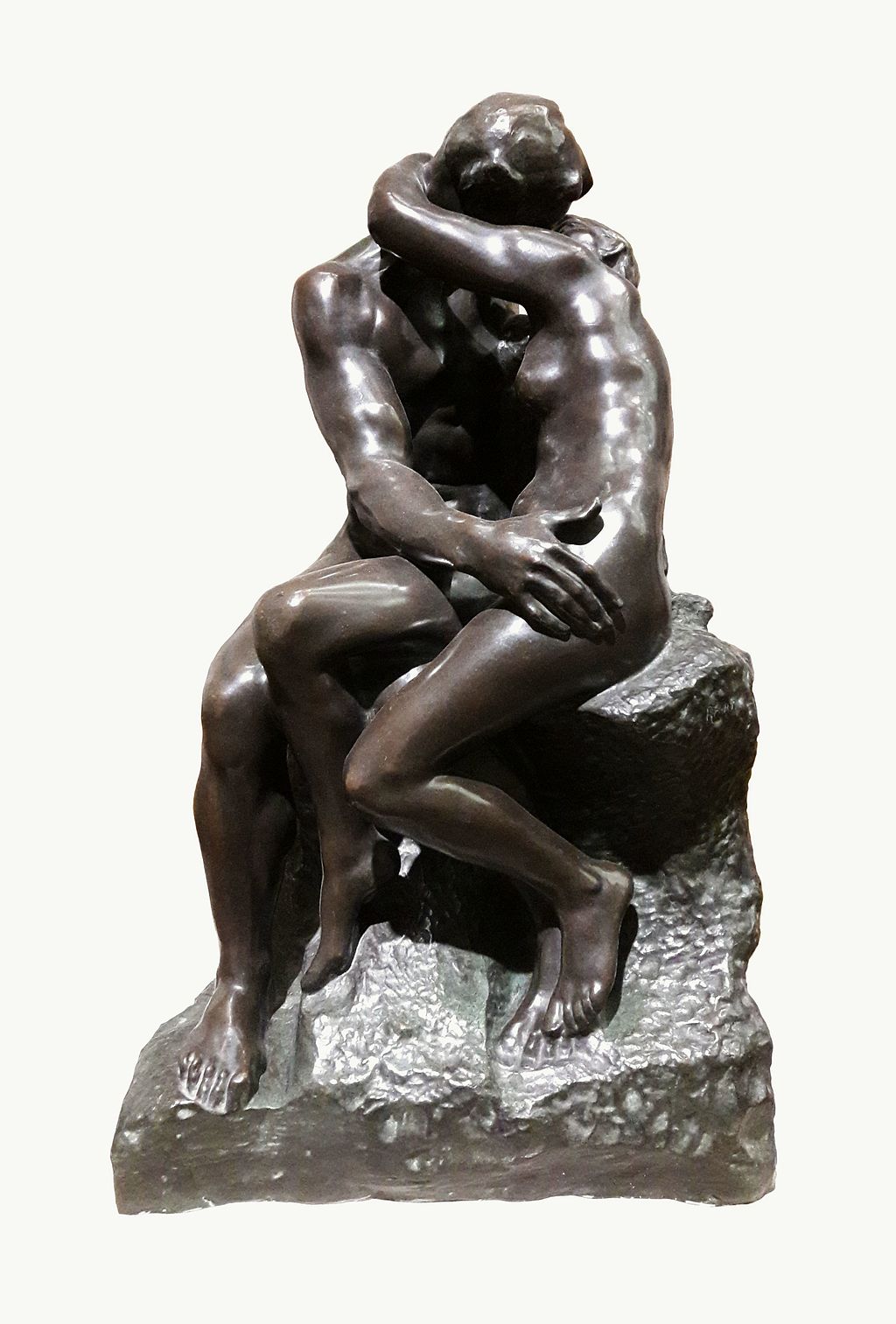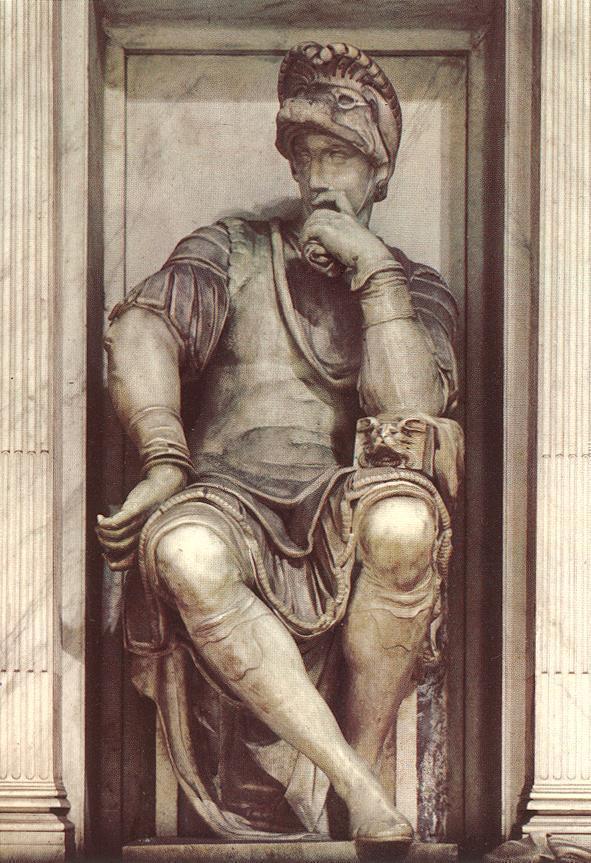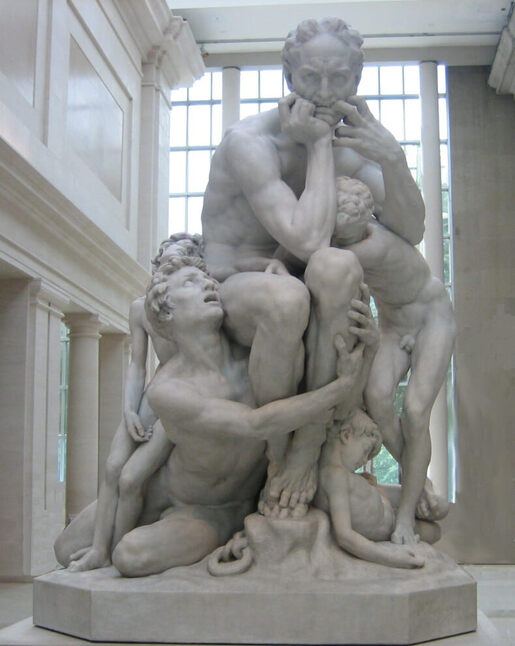|
Where?
What do you see? A young dancer of fourteen years old is shown at 70 percent of her real size (the sculpture is a bit taller than 3 foot or about 1 meter). She seems relaxed and is standing in ballet’s fourth position (there are seven positions for the feet in ballet, and the ballerina here has her feet in open fourth position – about 12 inches apart and facing different directions). The girl is sculpted realistically and Degas intends to show the hard life of a ballet dancer and what it does to her body. Her back leg supports most of her weight. She has thin legs and arms, holds her arms behind her back, and has her hands clasped together. She confidently holds up her chin, pushes her shoulders back, and her eyes are half closed. She wears ballet shoes, a real tutu made of tarlatan, and a gold-colored bodice (a vest) made of linen. The girl also wears a real ribbon in her plaited hair. Degas used real hair for this sculpture, which he covered in wax.
Copies: The National Gallery of Art holds two statues (the original wax statue and a bronze casting) of the Little Dancer Aged Fourteen as well as two nude studies for this statue. When Degas died, about 150 statues were found in his studio of which only one of the versions in the National Gallery of Art had been shown to the public at an exhibition. Many of these statues were in bad shape, but about half of these statues were repaired after his death. The National Gallery of Art has many of these original statues.
The surviving family of Degas decided to create about 22 bronze casts of these statues. Because of this, nowadays, bronze copies of the Little Dancer Aged Fourteen can be found in many other locations besides the ones mentioned on the top. For example, the statue is also in the the Art Institute of Chicago, Harvard Art Museums, Metropolitan Museum of Art (currently not on view), and the Norton Simon Museum. One of the bronze copies of the Little Dancer Aged Fourteen was sold in 2009 for $19 million.
Who is Degas? Hilaire-Germain-Edgar De Gas (1834-1917) was born in Paris. Whereas he spent most of his life in Paris, he also lived for three years in Italy and spent time in Florence, Naples, and Rome. He started as a more traditional painter by creating historical stories and portraits, but during the 1860s he changed his style and became one of the founders of Impressionism, together with artists like Cézanne, Manet, Monet, Pissarro, and Renoir.
Later on, he changed his focus and started to paint scenes from everyday life with a particular interest in dancers, theater, and horse racing. He moved on to focus on more realistic paintings, and one such example is Interior in the Philadelphia Museum of Art. He made statues mainly as training to understand the anatomy and movements of people.
Fun fact: When Degas showed this sculpture at an Impressionist exhibition in Paris in 1881, many people did not like it at all. For example, some people called the sculpture a monkey. It also did not help that the sculpture was on display in a glass vitrine. Sculptures typically were idealized versions of well-known people created in marble. Instead, Degas created an unknown young girl from Paris, and the girl did not look at all like a goddess. On top of that, he created this sculpture from beeswax and he added objects like a tutu to the statue. Because of the negative reactions Degas got, he removed the statue from the exhibition and stored it in his studio until his death.
Interested in a copy for yourself? Canvas or statue (Amazon links).
1 Comment
Where?
When? Rodin created the original sculpture in 1881. He created the first monumental-size sculpture in 1903 and after this many casts of the sculpture have been created, even after his death in 1917. What do you see? A sculpture of a muscular, naked man sitting on a rock. The man is in deep thought and uses his whole body to think. His head is bent forward and leans on his right hand. His wrinkled face, knitted eyebrows, swollen nostrils, compressed lips, and absent-minded gaze reinforce the idea that the man is deep in his thoughts and is completely unaware of the world around him. The man is struggling with his thoughts with every part of his body. Almost no part of his body is relaxed. Most muscles are tense, which is clear by looking at the clenched fist, the arched back, the legs below his body, and the squeezed toes. The statue is over six feet tall making the figure larger than life. It was the intention of Rodin to put the independent sculpture on top of a pedestal such that it would make a colossal impression on the viewers. Backstory: In 1880, Rodin received a large commission from the Directorate of Fine Arts in France to create the entrance doors for a new museum that was to be built (but never opened in the end). He was given the freedom to choose his own theme and decided on creating a scene from Dante’s book Inferno. Rodin was supposed to finish the project in five years but continued to work on the project for 37 years until his death in 1917. The doors – named The Gates of Hell – would eventually include a total of 180 different figures, and they would form the basis for many of Rodin’s most famous statues. Rodin originally created all figures in plaster, and the doors were then to be cast in bronze. The central and the most important part Rodin created for these doors was the statue of The Thinker (Le Penseur in French) who sits right above the two doors with all the characters from the Inferno behind him. The statue was about 27 inches (70 cm) high.
Multiple versions: The statue of The Thinker can be found all around the world. Rodin created the first version of this statue in plaster in 1881. In 1903, he completed the first monumental-size version of this statue. He considered it to be a remarkable piece and wrote to the client of his first bronze casting that he would ensure that only a few copies of the statue would ever be made. However, he did not keep his word.
During Rodin’s life, already more than 20 versions of The Thinker were produced. And after his death, the right for reproduction was turned over to the Republic of France. Nowadays, more than 70 bronze and plaster versions exist and are on display in Asia, Australia, Europe, North America, and South America. Interpretation: There are various interpretations of what and who The Thinker represents. When initially creating this statue as part of The Gates of Hell, Rodin meant the figure to represent Dante pondering about the fate of the damned people entering through the Gates of Hell. This interpretation is based on Dante’s book Inferno, the first part of his trilogy known as The Divine Comedy. When Rodin started to create independent versions, he started to consider different interpretations. Overall, he considered the statue to represent the struggle of the human mind. But he also started to see hope in it. The thoughts slowly become clear, and the man turns from a thinker, into a dreamer, and finally into a creator. Over time, other interpretations have also been given. Some consider the statue to represent Rodin himself. Others interpret the figure as Adam contemplating the sin he committed in Paradise. Who is Rodin? François Auguste René Rodin was born in 1840 in Paris, where he died 77 years later in 1917. He was rejected three times by the leading art school in Paris, the École des Beaux-Arts. It forced him to educate himself differently and this has contributed to his unique style. He was inspired by some of the great Renaissance sculptors like Donatello and Michelangelo. Most of Rodin's famous sculptures were originally intended for his commission of The Gates of Hell. Over time, he realized that he could turn many elements of The Gates of Hell into separate statues and some of these statues have achieved world fame. Among them are The Three Shades and The Kiss. Many of Rodin’s statues have been cast multiple times in bronze which means that his statues have spread across the world.
Why a bronze statue? Bronze is a combination of different metals. It consists primarily of copper (typically 85-90%) and tin (typically 10-15%), but can also contain minor quantities of other metals or nonmetals. It is an attractive material for sculptors for the following reasons.
Fun fact: While The Thinker is one of the most famous statues in the world, Rodin initially named this statue “the poet.” Later it was renamed based on suggestions by foundry workers that the sculpture was quite similar to a sculpture by Michelangelo on Lorenzo de’ Medici, Duke of Urbino. This sculpture was more popularly known as “Il Penseroso” (The Thinker), and this name was also given to Rodin’s statue. The Thinker also shows some resemblance to Ugolino and His Sons which was created by Jean-Baptiste Carpeaux in the 1860s. |
Categories
All
|
- Home
- Blog
-
Museums
- Alte Pinakothek
- Art Institute of Chicago
- Baltimore Museum of Art
- Barber Institute of Fine Arts
- Bargello
- Barnes Foundation
- British Museum
- Church of Sant’Anastasia
- Cleveland Museum of Art
- Courtauld Institute of Art
- Detroit Institute of Arts
- Frans Hals Museum
- Galleria Borghese
- Gallerie dell'Accademia
- Getty Museum
- Guggenheim
- Hermitage Museum
- Kunsthistorisches Museum
- Kunstmuseum Basel
- Legion of Honor Museum
- Louvre
- Mauritshuis
- Metropolitan Museum of Art
- Musee d’Orsay
- Museum of Fine Arts in Boston
- Museum of Modern Art
- National Gallery in London
- National Gallery of Art
- National Museum in Poznań
- Norton Simon Museum
- Ny Carlsberg Glyptotek
- Palace of Versailles
- Palazzo Pitti
- Palazzo Vecchio
- Petit Palais
- Philadelphia Museum of Art
- Prado
- Pushkin Museum
- Ravenna Art Museum
- Rijksmuseum
- San Diego Museum of Art
- Santa Maria delle Grazie
- St. Peter's Basilica
- Städel Museum
- Statens Museum for Kunst
- Tate Britain
- Tate Modern
- Timken Museum of Art
- Uffizi
- Vatican Museums
- Wallace Collection
-
Artists
- Altdorfer
- Anguissola
- Berlin Painter
- Bosch
- Botticelli
- Boucher
- Bronzino
- Bruegel the Elder
- Brunelleschi
- Cabanel
- Caillebotte
- Canova
- Caravaggio
- Carpeaux
- Cezanne
- Cimabue
- David
- Degas
- Delacroix
- De Maria
- Donatello
- El Greco
- Fontana
- Fra Angelico
- Fragonard
- Gauguin
- Gentileschi
- Gericault
- Gonzalez-Torres
- Goya
- Hals
- Hogarth
- Hokusai
- Ingres
- Leonardo da Vinci
- Lippi, Filippo
- Longhi, Barbara
- Lorrain
- Makovsky
- Manet
- Massys
- Matisse
- Merian
- Michelangelo
- Mochi
- Modigliani
- Monet
- Panini
- Parmigianino
- Perugino
- Picasso
- Pisanello
- Raphael
- Rembrandt
- Renoir
- Reynolds
- Rivera
- Rodin
- Rubens
- Scultori
- Seurat
- Steen
- Tintoretto
- Titian
- Toulouse-Lautrec
- Turner
- Uccello
- Van der Weyden
- Van Dyck
- Van Eyck
- Van Gogh
- Van Hemessen
- Vasari
- Velazquez
- Vermeer
- Veronese
- Vigée Le Brun
-
Locations
- Books
- About Us

